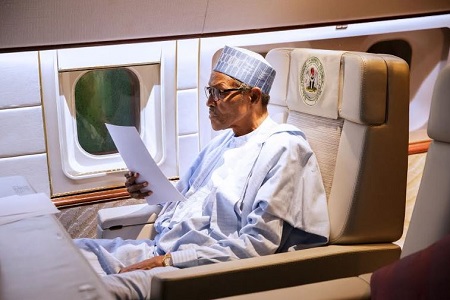
The recent claim by the Minister of Finance, Kemi Adeosun, that the N992.5 billion released to various federal ministries, departments and agencies, MDAs, for execution of capital projects under the 2016 budget was “the highest ever budgetary releases in Nigeria’s annual funding history” may not be entirely true, going by
Premium Times’ findings.
“So far, (about) N1 trillion has been released on capital (vote), and this is the highest so far in the history of this country,” the minister said during her interactive exchange with members of the House of Representatives Tactical Committee on Recession in her office in Abuja.
Details of the aggregate releases, Mrs. Adeosun said, include N870.1 billion as at the end of February 2017, in addition to another N65.4 billion.
She said other releases were N11.2 billion for manual authority to incur expenditure, AIEs, in February 2017 and N45.8 billion on March 13, 2017.
The releases, the minister explained, were for various projects, including the commencement of construction of the Lagos-Kano link dual standard railway line, rehabilitation of roads, expanding irrigation facilities to boost agriculture and upgrading of aviation infrastructure throughout the country.
Although the present administration unveiled Nigeria’s first ever zero-based budget, in excess of N6.06 trillion, a review of the budgets since 2010 showed that its N1.59 trillion appropriation for capital vote in 2016 only matched a similar provision under the Goodluck Jonathan administration’s N4.99 trillion budget in 2013 for the same purpose.
The Minister had told the Senate a fortnight ago that the difference between the release by the current administration and those of the previous administrations was that the ministry would not announce the release of any funds without cash-backing.
“All the releases by this administration are cash-backed. That is why all monies received by the MDAs are as good as cash,” she said.
Regardless, Premium Times’ findings revealed that the N992.5 billion cashed-backed releases in 2016 budget is lower than the over N1.004 trillion released and cash-backed by the Jonathan administration in 2013.
The 4th Quarter & Consolidated Budget Implementation Report 2013 by the Budget Office of the Federation showed that as at December 31, 2013, a total of N1.004 trillion was released and cash-backed for various capital projects earmarked for execution by government during the year.
The data from the Office of the Accountant General of the Federation, OAGF, showed that the figure was out of about N1.008 trillion released through four quarters development capital warrants.
Warrant for about N210.48 billion was for the first quarter; N168.45 billion for second; N181.44 billion for third and N111.06 billion for fourth, in addition to about N336.76 billion for AIEs for the implementation of capital projects/programmes by MDAs contained in the 2013 Appropriation Act.
A review of the performance indicators in the 2013 budget showed that a total of N968.93 billion, or 96.5 per cent of the total releases cash-backed were utilized by MDAs as at December 31, 2013, while the percentage utilisation of the 2016 is not yet available as the budget only expires on May 5.
Also, the utilization of N968.9 billion out of N1.004 trillion released and cash-backed in 2013 is relatively higher in real terms than the N992.5 billion released in the 2016 budget.
By January 2013 when the N4.99 trillion budget was prepared, based on the prevailing economic indices like inflation and exchange rate of the Naira, the value of the N1.004 trillion released and cash-backed for capital projects by MDAs was definitely higher than the N992.5 billion in 2016.
While inflation figures between January and December 2013 ranged between 9.03 and 7.96 per cent, the figures between January and December 2016 were between 9.62 and 18.55 per cent.
On the monetary policy side, while the 2013 budget was based on average exchange rate of about N160 to the dollar, the 2016 budget, was based on an average exchange rate of N197 and N199 to the dollar.
So, just sticking to the exchange rate upon which the budget was based, the N1.004 trillion released in 2013 gives $6.3 billion while the N992.5 billion released in 2016 gives $5.0 billion
Also, the unveiling of the floating exchange rate policy by the Central Bank of Nigeria, CBN, in June 2016 massively impacted negatively the value of the Naira. The new policy not only effectively removed the controls on Naira value, it abolished the N197-N199 exchange rate band in the interbank market, thereby opening the window for the massive devaluation of the Naira against other international currencies, particularly the Dollar, Pound and Euro.
Since the introduction of the new exchange rate policy by the CBN, the value of the Naira at the interbank market plummeted to about N311 to the dollar in May 2016, before a gradual improvement to the current rate of N306 to the dollar, factors which further diminish the real value of the 2016 capital funds release.
EXPERTS QUESTION MINISTER’S CLAIM
Financial experts told PREMIUM TIMES current economic indices were not in support of the minister’s claim.
The Lead Director, Centre for Social Justice, CENSOJ, Eze Onyekpere, said the minister’s claim did not find validation in the various reports published by the Budget Office of the Federation on budget performance over the years.
“Go and read the various monitoring reports on budget performances year by year to appreciate the difference. The minister’s claim cannot be true,” he said.
“Also, look at the historical data on the value of the Naira. Check what N200 to the dollar bought few years ago and what N400 to the dollar would buy today. What this means is that more money has lesser value to chase fewer goods.”
For the Chief Executive Officer, Economic Associates Limited, Ayo Teriba, while the minister’s claim might not be true, discussions on economic figures cannot be taken in nominal terms.
“If the disbursement of that figure (N992.5 billion) was when Naira was exchanging for N197/N199 to the dollar, the same cannot be said when Naira is exchanging for N300/N400 to the dollar. One would be contending true with a rapidly declining Naira value today,” Mr. Teriba said.
“In nominal terms, peak capital spending of N1.15 trillion occurred in 2009, followed by N1.1 trillion in 2013.
Therefore, the minister could not be right in her claim that 2016 is a peak year for capital spending,” Mr Teriba said.
“Relative to gross domestic product, GDP, capital spending of N0.93 trillion in 2016 was 0.9 percent of GDP, making 2016 one of the only three years in Nigeria’s history that capital spending was below one percent of GDP.
“The other two years Nigeria had it so poor was 2014 (0.88 percent of GDP) and 2015 (0.87 percent of GDP),” he added.
The chief executive of Pan Africa Development Corporation, Odilim Enwegbara, said drawing a factual conclusion on the issue could be based on the review of the fiscal and monetary indices of the economy, particularly inflationary trends and exchange rate of the Naira over the years.
“The exchange rate in 2016 was N197/N199 to the dollar, against the N306 exchange rate to the dollar today. Clearly, those executing the projects, and need to import materials, would be doing so at a higher exchange rate.
“So, definitely the value of the Naira today would not be the same as in the previous years. In that case, government may have released more money, but the reality is that the value today is lower than a few years back,” Mr. Enwegbara said.
*******
Culled from Premium Times





